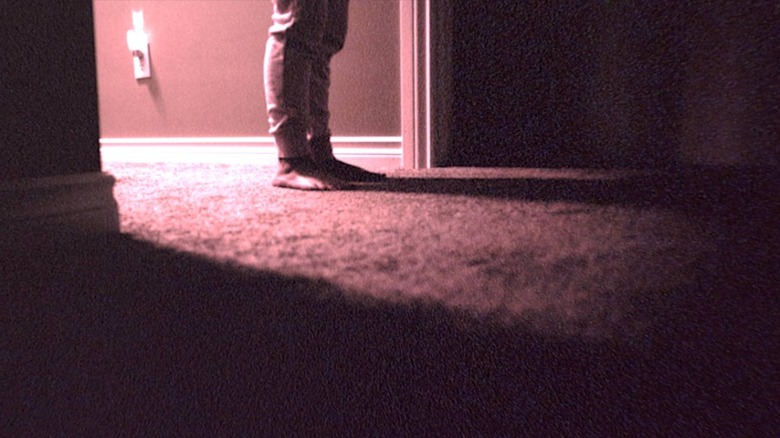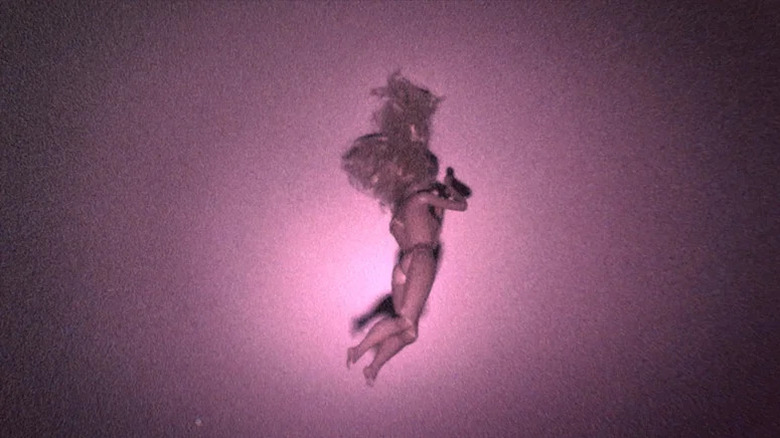Skinamarink Ending Explained: The Psychology Of Nightmares, And The Tragedy Of A Family Falling Apart
This post contains major spoilers for the film "Skinamarink."
There are two ways to look at Kyle Edward Ball's 2023 horror film "Skinamarink." On the one hand, there is something of a plot that can be extrapolated from the film's eerie, grainy visuals and weird waterlogged whispers. Despite its long, abstract takes and plentiful off-screen dialogue, there is drama to be discovered. On another hand, "Skinamarink" can be appreciated merely for its visceral power. It can terrify a viewer outside of any conventional meaning or recognizable story machinations. On its most stirring level, "Skinamarink" captures what it feels like to have a nightmare.
On the latter point, it's important to look into the psychology of dreams.
"Skinamarink" was filmed in Ball's own childhood home, and is about two young children, only four and six years old, wandering the hallways at 3 a.m. Thanks to the film's unique visual style, their only illumination is the flickering TV set, tuned to half-absorbed public-domain cartoons. There is constantly hissing and shuffling white noise on the soundtrack, interrupted by dark whispers and strange, terrifying demands. The windows and doors have vanished. When one of the children wanders into their parents' room, their mom won't look at them (audiences only see the back of her head) and their father appears to be missing.
"Look under the bed," we hear.
There is no story to "Skinamarink," per se, but Ball expertly constructs the rising and falling action of a genuine nightmare, ramming a melon baller deep into our cerebrum and scooping out ancient fears we had long ago forgotten about. "Skinamarink" requires a heck of a lot of patience — there is little dialogue, few shots of peoples' faces, and, as mentioned, no traditional plot — but those willing to face its challenges will be rewarded with one of the single most frightening films in recent memory. This is no jump-scare-fueled haunted house. This is a direct infusion of childhood fear.
Skinamarink captures the feeling of a real nightmare
It's important to know that Ball made a name for himself on his YouTube channel, Bitesized Nightmares. Viewers would mail in descriptions of their most frightening dream experiences, and Ball would recreate them on film. The young Canadian filmmaker seems to take a lot of inspiration from a certain kind of barely-remembered childhood night terror experience. Any child who grew up infected by nightmares will recognize the images and feelings of "Skinamarink."
Throughout the movie, as the children wander the hallways, increasingly scary things begin happening. One by one, toys stick to the ceiling. The geography of the house seems to change. It also becomes clear that there is some kind of undefined ... "presence" in the house, something that feels demonic but remains unseen. A deep, scary voice begins to interject, whispering to the kids, although the speaker is never revealed. Occasionally, one of the parents will whisper something scary and detached to their children, including a dark demand involving a knife. In a more conventional horror movie, these events would be explained by well-worn exposition about demonology. But "Skinamarink" is a horror film refreshingly without rules.
The final scenes find the four-year-old boy Kevin (Lucas Paul) witnessing all of his toys losing their gravity and cluttering the ceiling above. Eventually, he too will be on the ceiling. He will wander into once-familiar hallways, but the world is literally topsy-turvy. Reality is upside down. The camera finally reveals the exterior of Kevin's home, and it seems to have vanished into another realm. Reality has dissipated. Kevin seems to know something else is nearby. Something that is not his parents or his sister. The final shot will be a dark, empty space.
Barely visible through the film's cinematic grain is a pale human (?) face. Kevin, still never daring to speak above a whisper, asks this thing "What's your name?"
It's literal nightmare fuel.
Skinamarink is a study of Jungian archetypes
What exactly is that being? Readers of psychologist Carl Jung might describe it as the Shadow. And if you will indulge me for a moment, we can use "Skinamarink" as a study into Jungian archetypes. If we're to accept that "Skinamarink" takes place inside a child's nightmare, then it's fair to use dream language to interpret its images.
Anyone who has taken a Psychology 101 class will likely be able to list Jung's four Dream Archetypes: the Anima/Animus, the Persona, the Self, and the Shadow. Briefly, the Anima/Animus is the gender balance in one's mind. It's the feminine part of a masculine brain, or the masculine part of a feminine brain. The Persona is the "social" part of the brain, the part we present to the world. The Self is, well, self-explanatory, being the unique identity of an individual as it exists deep inside their mind. It's essentially the first-person "protagonist" in a dream. The Shadow, meanwhile, is the "antagonist," the monster in our dreams. By Jung's estimation, it tends to represent our deepest fears.
The face in "Skinamarink" is the Shadow. It's a free-floating being made of fear that lives inside all our brains.
Although we may argue that "Skinamarink" is entirely a dream, it's an interpretation that won't make the film any less scary. The children are exploring their own minds and their own fears. Common nightmares as a child typically involve being in the home but discovering it to have been altered or mutated in some way. Perhaps the windows are gone. The inability to speak up or to find help is also common, as when Kevin calls 9-1-1 and explains — without words — that something horrible has happened. Much of the dialogue in "Skinamarink" is inaudible, and subtitles are used.
Did Kyle Edward Ball make Skinamarink as a psychology study?
The Shadow appears to be some kind of controlling force of the eerie events of "Skinamarink." Jung posited that the Animus and Anima form in infancy, and are represented in dreams by a strange and powerful, but often friendly, godlike figure. One might say that the strange, old cartoons might be the Animae of the children, providing light and presenting scenarios of power. But, frighteningly, it is boxed up. It cannot affect the events of the world. It can only watch and narrate.
The Persona of Jung's teachings has a few subcategories, but it's essentially the "hero" that the Self can make itself into, or at least tap into. One of the said subcategories is called the Divine Child, which — as its Christian-sounding name would imply — represents a powerful, divine innocence.
But, it's worth noting that the children in "Skinamarink" have no power. This is not a story of triumph or struggle, it's a story of fear. The Shadow appears and the world dissipates. It cannot be stopped. It has no name. In "Skinamarink," including in the movie's best jump scare, the Shadow is everything.
But then, what if it's not the Shadow? The Jungian interpretation is merely a way to intellectualize the images and the fear of "Skinamarink." There may, however, be a deeply emotional element at play, and one that points to a personal tragedy some viewers have gleaned from the film's details.
Is there a literal plot to Skinamarink?
Right at the beginning of the movie, for instance, Kevin is said to have fallen down the stairs. His off-screen father tells Kaylee (Dali Rose Tetreault) that Kevin is okay, but later dialogue notes that he was maybe taken to a hospital. While these seemingly disconnected scenes easily fit into a certain nightmare logic, there's an interpretation of "Skinamarink" that makes them literal. This, one might say, is the "Johnny Got His Gun" interpretation of the movie.
If Kevin's fall down the stairs was a literal event, then Kevin was injured, having hit his head. It's possible that, at that moment, Kevin was knocked unconscious and fell into a coma. It was suggested by Matthew Patrick on his Film Theory YouTube channel that Kevin was also suffering from a brain tumor. Late in the film, the audience sees family pictures wherein people's faces are distorted or their heads are missing, and there is a notorious sequence where Kevin is entreated by a mysterious voice that he stick a knife in his eye. Patrick knew that eye pain and prosopagnosia (face blindness) were symptoms of a brain tumor, and came to the conclusion that Kevin was not only in a coma after a fall, but that he was still suffering symptoms of cancer.
The idea that Kevin is in a coma would explain a lot of the film's imagery. If the doors and windows of Kevin's house are vanishing, then they are simply matching the cold, windowless room where hospital beds are kept. If he's constantly watching cartoons, it's implied that a TV is in his hospital room as well. If he fell upside down on a staircase, then his whole world would likewise flip, explaining why, by the film's end, everything seems to be on the ceiling.
By the end of the film, 572 days have passed, implying that Kevin had been bedridden that whole time. A four-year-old child had now spent a third of his life in bed. If that's the case, it might explain, perhaps tragically, why Kevin and Kaylee's parents vanish. First dad, then mom. Saddened parents would indeed come to visit their son, but it seems that they stopped coming to see him after a while. In Kevin's mind, they vanished.
The monster in Skinamarink explained
Patrick also had a theory that the monster at the end of "Skinamarink" was not a shadow, but a welcoming figure. In "Skinamarink," the mother (Jaime Hill) seems to be alone. There are whispered questions about why mom is crying, and then she vanishes. There is an audible snapping noise. This is accompanied by an image of a Barbie doll that seems to be hanging from the ceiling. Hanging? Did the mom, distraught over the fate of her son, take her own life? It's an interesting theory.
If it's a sound theory (and there are plenty of other theories out there), then the shadowy demon figure at the conclusion of "Skinamarink" is not Jung's Shadow at all, but Kevin's mother, there in the afterlife, welcoming him. He is at death's door. In a world without doors and windows, he finally found a way out. The door reappeared. But the only thing beyond his house, beyond his memories, beyond his ostensible illness, is blackness. An abyss. "Skinamarink," by this interpretation, is the dark vision of the final days of a young boy's life before he drifts away into death.
The coma theory, however, takes a few rounds of mental gymnastics. The nightmare theory feels more authentic. Case in point: One of the public domain cartoons that Kevin watches is Dave Fleicher's 1931 short "Bimbo's Initiation." In that cartoon, the feckless hero Bimbo falls into a sewer and lands in an underground clubhouse ... where the doors and windows vanish when he tries to exit. If Kevin watched that film before bed, or couldn't sleep and watched it in the middle of the night, one can easily see him having a nightmare wherein his own home sported windows and doors that vanished.
Either way, Kevin didn't have a very good night.





